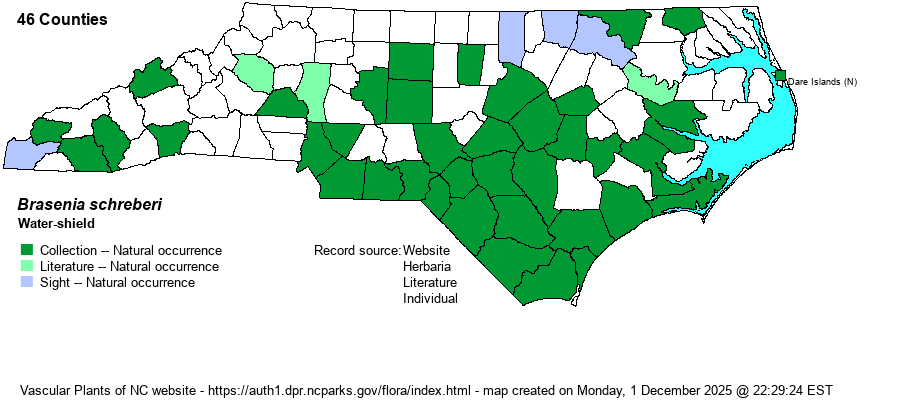| Author | J.F. Gmelin | |
| Distribution | Found throughout the southern half of the Coastal Plain; widely scattered over most of the remainder of the state, though could be legitimately absent from the northern Mountains and northwestern Piedmont. The lack of records for the counties north and south of Albemarle Sound is puzzling, as suitable habitat seems to be present. There is a single specimen from the Outer Banks, at Nags Head Woods.
This is a very widespread species, being found across all of eastern North America, from eastern N.S. and MN south to FL and eastern TX. It is sparsely distributed in montane regions. It is also found along the Pacific Coast, tropical America, and the Old World. | |
| Abundance | Fairly common to locally common in the southern half of the Coastal Plain, including the Sandhills. Elsewhere, rare to uncommon and local - in the southern half of the Mountains, most of the Piedmont, and at least the northwestern Coastal Plain. Surprisingly absent from the northeastern counties, as it is found over much of southeastern VA. | |
| Habitat | This is a species of still waters, both in blackwater or brownwater conditions. It occurs in ponds, lakes, impoundments, beaver ponds, and sluggish streams, from shady to fully open conditions. | |
| Phenology | Blooms from June to October, and fruits shortly after blooming. | |
| Identification | This is a very easily identified floating plant, such that even a caveman can identify it! It has floating leaves, several per plant; these leaves are elliptical in shape with rounded ends, and roughly 2-3 inches long and half as wide. Each leaf has a peltate stem attachment from below; that is, there is a small indention on the upper leaf surface where the underwater stem attaches to the bottom of the leaf. The flowers are also unique -- this is a monotypic genus -- as each plant has a single stem emerging from the water surface for about 2-3 inches, topped by a fairly small, dull (or watery) purplish flower, with 3 or 4 petals, that is about 3/4-inch across. The many stamens are bright red, as well; these may catch your attention more than the color of the petals, especially as the petals are recurved to expose the stamens and their bright color. Hardly any other aquatic/floating plant has purple flowers, but neither does any have peltate elliptic leaves. Biologists often run into this species frequently in the Coastal Plain, such as around the shores of beaver ponds or millponds; usually many dozens of plants dot the waters close to shore. If you are inclined to pull a plant out of the water, you can get hold of "botanical snot", the thick and slimy substance that coats much of the underwater parts of the plant! | |
| Taxonomic Comments | None. As mentioned above, the genus consists of just this single species.
| |
| Other Common Name(s) | None | |
| State Rank | S3S4 [S4] | |
| Global Rank | G5 | |
| State Status | | |
| US Status | | |
| USACE-agcp | OBL link |
| USACE-emp | OBL link |

